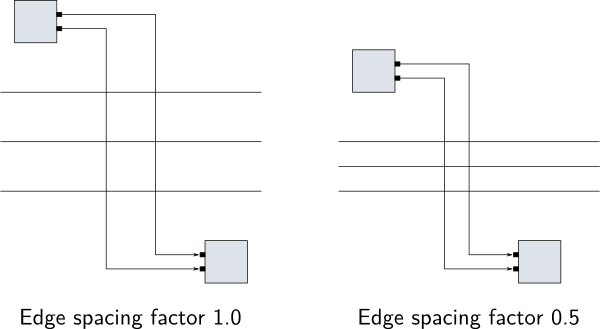...
| Option | ID | Type | Applies to | Default |
|---|
| Crossing Minimization | de.cau.cs.kieler.klay.layered.crossMin | Enum | Parents | LAYER_SWEEP |
| Cycle Breaking | de.cau.cs.kieler.klay.layered.cycleBreaking | Enum | Parents | GREEDY |
Distribute Nodes
(currently unsupported) | de.cau.cs.kieler.klay.layered.distributeNodes | Boolean | Parents | false |
| Edge Spacing Factor | de.cau.cs.kieler.klay.layered.edgeSpacingFactor | Float | Parents | 0.5 |
| Feedback Edges | de.cau.cs.kieler.klay.layered.feedBackEdges | Boolean | Parents | false |
| Fixed Alignment | de.cau.cs.kieler.klay.layered.fixedAlignment | Enum | Parents | NONE |
| Interactive Reference Point | de.cau.cs.kieler.klay.layered.interactiveReferencePoint | Enum | Parents | CENTER |
| Label Side | de.cau.cs.kieler.klay.layered.LabelSide | Enum | Parents | SMART |
| Layer Constraint | de.cau.cs.kieler.klay.layered.layerConstraint | Enum | Nodes | NONE |
| Merge Edges | de.cau.cs.kieler.klay.layered.mergePorts | Boolean | Parents | false |
| Node Layering | de.cau.cs.kieler.klay.layered.nodeLayering | Enum | Parents | NETWORK_SIMPLEX |
| Node Placement | de.cau.cs.kieler.klay.layered.nodePlace | Enum | Parents | BRANDES_KOEPF |
| Port Anchor Offset | de.cau.cs.kieler.klay.layered.portAnchor | Object | Ports | |
| Thoroughness | de.cau.cs.kieler.klay.layered.thoroughness | Int | Parents | 7 |
...
This section explains every layout option in more detail. See the KIML documentation for more information on KIML layout options. Those options are only mentioned here if KLay Layered adds some custom behavior.
Crossing Minimization
| Anchor |
|---|
| crossingMinimization |
|---|
| crossingMinimization |
|---|
|
Crossing minimization determines the ordering of nodes in each layer, which influences the number of edge crossings. This option switches between one of several algorithms that can be used to minimize crossings. Possible values are:
- LAYER_SWEEP
The layer sweep algorithm iterates multiple times over the layers, trying to find node orderings that minimize the number of crossings. The algorithm uses randomization to increase the odds of finding a good result. To improve its results, consider increasing the Thoroughness option, which influences the number of iterations done. The Randomization seed also influences results. - INTERACTIVE
Orders the nodes of each layer by comparing their positions before the layout algorithm was started. The idea is that the relative order of nodes as it was before layout was applied is not changed. This of course requires valid positions for all nodes to have been set on the input graph before calling the layout algorithm. The interactive layer sweep algorithm uses the Interactive Reference Point option to determine which reference point of nodes are used to compare positions.
Cycle Breaking
| Anchor |
|---|
| cycleBreaking |
|---|
| cycleBreaking |
|---|
|
KLay Layered tries to position nodes in a way that all edges point rightwards. This is not possible if the input graph has cycles. Such cycles have to be broken by reversing as few edges as possible. The reversed edges end up pointing leftwards in the resulting diagram. There are different cycle breaking algorithms available:
- GREEDY
This algorithm reverses edges greedily. The algorithm tries to avoid edges that have the Priority property set. - INTERACTIVE
The interactive algorithm tries to reverse edges that already pointed leftwards in the input graph. This requires node and port coordinates to have been set to sensible values.
Edge Spacing Factor
| Anchor |
|---|
| edgeSpacingFactor |
|---|
| edgeSpacingFactor |
|---|
|
The edge spacing factor determines the amount of space between edges, relative to the regular Spacing value. The idea is that we don't need as much space between edges as we do between nodes.
 Image Added
Image Added
Interactive Reference Point
| Anchor |
|---|
| interactiveReferencePoint |
|---|
| interactiveReferencePoint |
|---|
|
Interactive layering, crossing minimization, and cycle breaking algorithms use node positions to sort nodes into layers or to determine the order of nodes in each layer. However, it is unclear if for example the top left corners of nodes should be compared, or the bottom left corners — different settings might lead to different results. The interactive reference point determines which part of nodes is used to compare their positions. It provides the following settings:
- TOP_LEFT
The top left corner of a node is taken as the reference point. - CENTER
The center of a node is taken as the reference point.
Thoroughness
There are heuristics in use all over KLay Layered whose results often improve with the number of iterations computed. The thoroughness is a measure for telling KLay Layered to compute more iterations to improve the quality of results, at the expense of performance.
